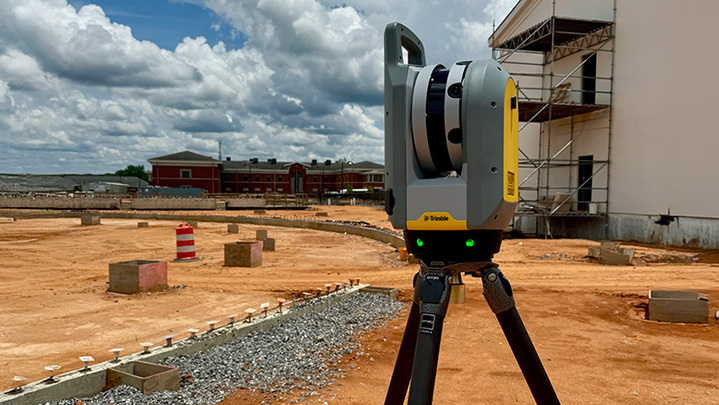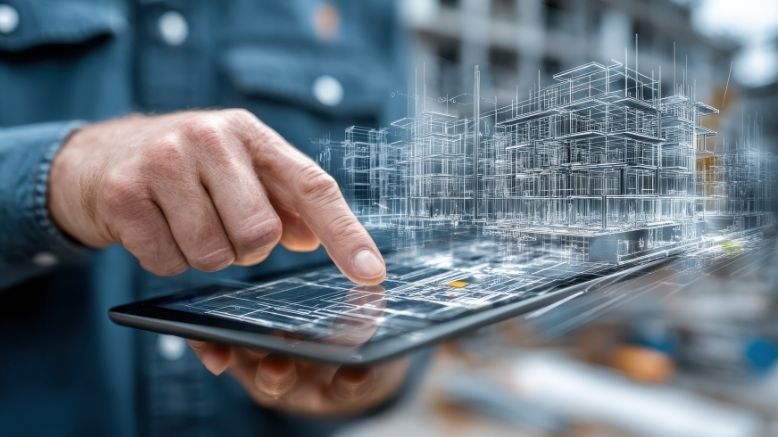— 5 min read
How Laser Scanning Improves Accuracy and Accountability in Construction


Last Updated Sep 23, 2025

Paul Hedgepath
Director of Virtual Construction
With over 25 years in the AEC industry, Paul Hedgepath has managed trade coordination and team training on more than 100 projects, including airports, stadiums, data centers, hotels, schools, and over 60 healthcare projects. His expertise spans 3D workflows, Procore implementation, AI project deployment, drone technology, 360-degree photography, laser scanning, and other advanced tools to boost accuracy and efficiency. Since 1998, Paul has focused on streamlining processes and solving challenges to add significant value to each project.

Kristen Frisa
Contributing Writer
110 articles
Kristen Frisa is a contributing writer for Procore. She also contributes to a variety of industry publications as a freelance writer focused on finance and construction technology. Kristen holds a Bachelor of Arts in Philosophy and History from Western University, with a post-graduate certificate in journalism from Sheridan College. She lives in Ontario, Canada.
Last Updated Sep 23, 2025

Laser scanning in construction is a key tool teams can use to gain a deeper understanding of various aspects of their projects. Laser scanning effectively bridges the gap between digital design and physical construction. When it's integrated deeply into project workflows, it creates better verification and coordination and enhances storytelling, accountability and risk reduction.
This article will discuss how laser scanning can be used throughout construction projects and the benefits it can provide for teams, owners and overall project outcomes.
Table of contents
How Laser Scanning is Used in Construction
Laser scanning — also known as reality capture or LiDAR (Light Detection and Ranging) — captures accurate 3D representations of physical spaces using high-speed laser scanners. These scanners record millions of data points, producing a “point cloud” that can be converted into detailed models or used as a direct reference against design files.
Laser scanning is a valuable tool construction teams can use from preconstruction through closeout. Laser scans help create true-to-life records of what’s happening on the project site that can serve many different purposes as the project progresses.
Project Planning
During preconstruction or early site investigation, scanning provides an as-is baseline of existing conditions that is far more accurate and detailed than manual tape-and-laser measurements. On renovation projects or tying into existing structures, this initial scan prevents a lot of guesswork and surprises.
Clash Avoidance
One of the most valuable applications of laser scanning on construction projects is capturing existing overhead mechanical, electrical and plumbing (MEP) systems and integrating that scan data into a 3D model. This allows project teams to coordinate new MEP systems in real-time with the existing ones. Instead of relying on outdated as-builts or ceiling tile inspections, laser scans record what’s there. The resulting hybrid model — existing conditions overlaid with new design — gives teams and trade partners a clear, clash-free path forward.
Mapping MEP
As the project moves forward, scans create applicable in-wall and above-ceiling verification, capturing installations before they’re covered. This gives project teams and the owner a visual and measurable record of where mechanical, electrical and plumbing systems are installed, which can be helpful for facilities maintenance and repair. Healthcare projects often require laser scans of MEP systems.
Early Corrective Action
Laser scans can allow project teams to overlay layers to make sure elements line up as they should. For example, teams can scan installed steel, deck or block walls, then overlay those scans with the coordinated 3D model, providing an immediate comparison: Are openings in the right spot? Is a beam installed with the proper camber? Have sleeves been placed in the correct layout?
These comparisons allow teams to catch and correct layout errors before they become costly change orders.
The Benefits of Using Laser Scanning Throughout Construction Projects
Laser scans can be used to plan, inform and correct construction activities over the course of project builds, for better quality, less rework and easier ongoing maintenance efforts.
1. Accuracy That Prevents Rework
Laser scans' primary benefit is accuracy–laser scans provide millimeter-level precision. Full-color point cloud aligned to project coordinates allows teams to measure dimensions, confirm plumb and level and compare installation to design models with exacting detail. Extreme precision reduces rework significantly, especially with structural steel and complex MEP layouts.
2. Improved Coordination
Laser scanning helps identify field deviations and informs clash detection. Even when the BIM coordination process is clean, field conditions rarely match the model exactly. Scanning allows for early detection and adjustment of any deviations. Combining point clouds with BIM software gives field teams and VDC staff tools they can trust.
Capturing existing overhead MEP and integrating that into the model ensures that new systems can be routed without interference, which is especially critical in renovations, additions or expansions where every inch matters.
3. Enhanced Communication
Scans are visual aids that don’t require expertise in Revit or CAD to provide helpful information and understanding. Construction leaders can take a 3D scan of a jobsite and walk the owner through a virtual space before walls go up, show a superintendent why something must be moved, or prove that a sub installed something incorrectly. Scans provide a clear, shared source of truth.
4. Managing Documentation
Laser scans are timestamped records of work in place. If there’s a dispute about what was installed, teams don’t have to rely on memory or blurry photos — they can pull the scan. This kind of documentation is extremely valuable for healthcare projects and government jobs. It supports pay apps, protects against claims and shows inspectors that contractors are on top of quality.
5. Future-Proofing for Operations and Maintenance
By capturing scans at various stages, contractors build a visual archive of the building’s internal systems. When facilities teams need to locate a valve or run a new line, they don’t have to open walls—they can refer to the scan and see what’s behind them. Behind-the-walls visibility is especially valuable in hospitals, labs and universities.
Free AI in Construction Course with Hugh Seaton
Start learning today with industry expert Hugh Seaton and discover how AI can boost efficiency, reduce risk, and transform your projects.

Integrating Laser Scanning into Construction Work
Integrating laser scanning into a construction company’s workflow takes planning. Buying a scanner isn’t enough on its own — there needs to be people on board who understand registration, point cloud processing and alignment with models. Construction teams should be ready to train both VDC and field staff on how to request scans, review them and use them in coordination meetings.
Scanners can be used alongside total stations and BIM software tools: For example, when teams scan a slab or wall, they can compare it immediately to the coordinated model in the field. Using these tools together closes the loop between design intent and physical construction. It also builds trust — owners, architects and subcontractors can see contractors proactively verifying work, not just reacting to issues.
Enhancing Project Knowledge and Communication With Laser Scanning
Laser scanning is a reliable tool for delivering quality and controlling risk on construction projects. When used throughout the construction process, scans empower teams with better data, improve decision-making and bring transparency to the construction process.
As contractors continue to push the boundaries of what construction technology can do, laser scanning remains a foundational part of the construction workflow, connecting the digital to the physical in ways that can add value for everyone on the project.
Was this article helpful?
Thank you for your submission.
100%
0%
You voted that this article was . Was this a mistake? If so, change your vote
Scroll less, learn more about construction.
Subscribe to The Blueprint, Procore’s construction newsletter, to get content from industry experts delivered straight to your inbox.
By clicking this button, you agree to our Privacy Notice and Terms of Service.
Thank you!
You’re signed up to receive The Blueprint newsletter from Procore. You can unsubscribe at any time.
Categories:
Written by

Paul Hedgepath
Director of Virtual Construction | MJ Harris Construction
With over 25 years in the AEC industry, Paul Hedgepath has managed trade coordination and team training on more than 100 projects, including airports, stadiums, data centers, hotels, schools, and over 60 healthcare projects. His expertise spans 3D workflows, Procore implementation, AI project deployment, drone technology, 360-degree photography, laser scanning, and other advanced tools to boost accuracy and efficiency. Since 1998, Paul has focused on streamlining processes and solving challenges to add significant value to each project.
View profile
Kristen Frisa
Contributing Writer | Procore
110 articles
Kristen Frisa is a contributing writer for Procore. She also contributes to a variety of industry publications as a freelance writer focused on finance and construction technology. Kristen holds a Bachelor of Arts in Philosophy and History from Western University, with a post-graduate certificate in journalism from Sheridan College. She lives in Ontario, Canada.
View profileExplore more helpful resources

How Construction Technology is Transforming Safety, Efficiency, and Sustainability
The construction industry is taking part in a remarkable transformation as the sophistication and availability of construction technology have exploded in recent years. The term “construction technology” has become a...

AI Agents for Construction: The Future of Efficiency Is Here
As the adoption of AI increases, construction leaders need to understand how AI agents for construction can be used to efficiently build today’s complex projects. This article will explore how...

Hugh Seaton Answers Construction’s Top AI Questions
In construction, artificial intelligence is stepping up as a tool for tackling both narrow issues and big ideas. Still, construction pros have questions. Construction-industry AI expert Hugh Seaton answered their...

4 Easy Steps to Start Using AI Today
It’s time to stop procrastinating: The transformative power of artificial intelligence is at hand for construction pros who are already wading in. Those who take small steps today will be...
Free Tools
Calculators
Use our calculators to estimate the cost of construction materials for your next project.
Templates
Find a template to help you with your construction project tasks.
Material Price Tracker
Get the latest U.S. retail prices and view historical trends for common building materials.
Glossary
Explore key terms and phrases used in the industry.
